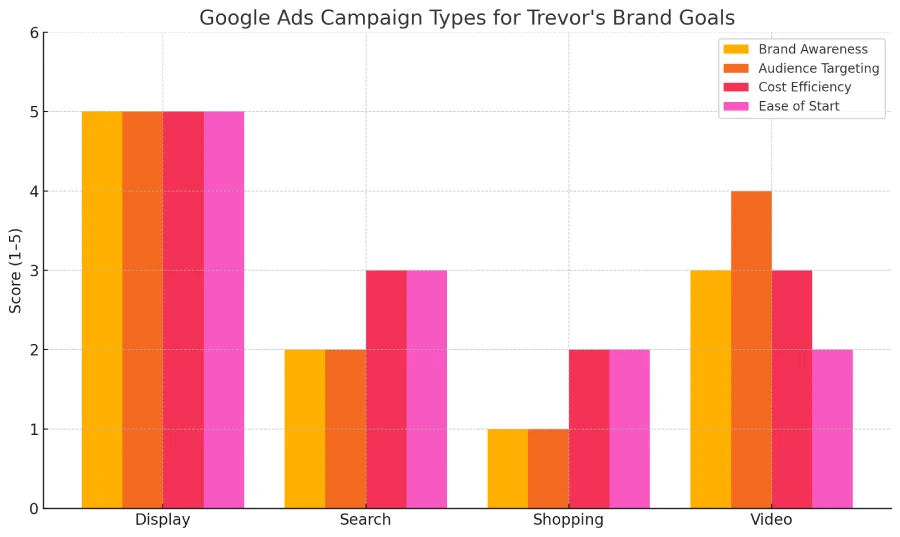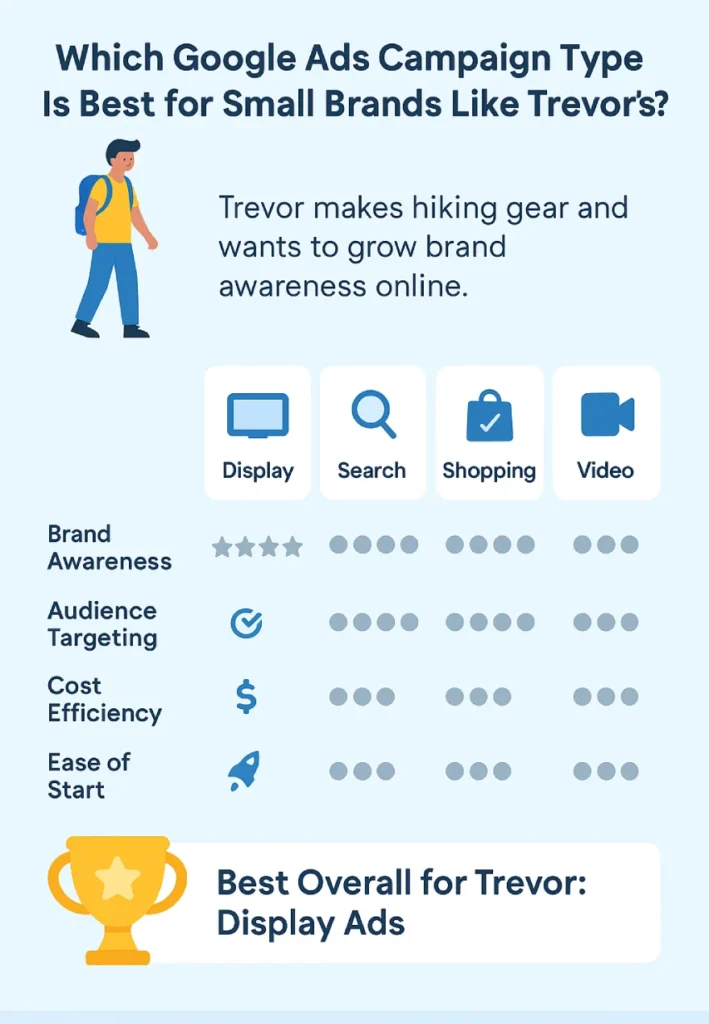I recently passed the Google Ads Display Certification exam and scored over 97%. One of the questions really stuck with me, not because it was tough, but because it helped me finally understand how different Google Ads campaign types are used in real-world situations.
In this post, I’ll explain the question, show the right answer and why it’s correct, go over why the other answers are wrong, and explain how Display Ads help small brands like Trevor’s get visibility fast. I’ll also share a real-life example, a comparison chart, and some helpful FAQs to make it super clear. Let’s dive in! 💡
Question
Trevor owns a manufacturing business that makes specialized hiking and rock climbing gear. He is a very small player in the market, but he is ready to scale up his business. Which Google Ads campaign type should Trevor use to increase his brand’s exposure and reach audiences with interests in hiking and rock climbing across the web?
- Shopping
- Search
- Video
- Display
Here is the correct answer:
✅ Display
If you’re interested, you can take the exam here: Google Ads Display Certification via Skillshop.
Why This Answer Is Correct:
Google Display Ads are designed to help businesses reach large audiences, especially when they want to build brand awareness.
Trevor needs to:
- Get his brand in front of new, relevant people
- Target outdoor lovers, hikers, and climbers
- Scale visibility with a smaller budget
Display Ads do all of that:
- Show on over 2 million websites and apps
- Target by interest (e.g., “Outdoor Enthusiasts”)
- Appear on blogs, news sites, and YouTube
- Cost less per impression than Search
Display is perfect when your goal is exposure, not immediate sales.
Why the Other Options Are Wrong:
- Shopping
❌ Focuses on product-level searches (price, image, product title). It’s better for when users are actively comparing products and ready to buy. Trevor’s brand is still new and needs exposure first. - Search
❌ Targets high-intent searches like “buy rock climbing gear.” It’s more expensive and competitive. Trevor’s audience may not be actively searching yet. - Video
❌ Video campaigns require well-produced content and usually more budget. Trevor can explore video later, but Display is quicker, easier, and more cost-effective for now.

Best Campaign Types by Goal
| Campaign Type | Best For | Good for Trevor? | Why / Why Not |
|---|---|---|---|
| ✅ Display | Brand awareness, interest targeting | ✅ Yes | Broad reach, low cost, perfect for small brands |
| ❌ Shopping | Product promotion, high-intent | ❌ No | Too focused on sales, not exposure |
| ❌ Search | Keyword-driven conversions | ❌ No | Better for mature brands with demand |
| ❌ Video | Engagement, storytelling | ❌ Not yet | Requires video content and higher ad budgets |

Real-Life Example:
Trevor owns ClimbTrek Gear, a new company selling lightweight carabiners and climbing bags. He creates a Display ad with the headline:
“Climb Smarter. Gear Made for Real Climbers.”
He targets:
- Affinity Audiences like “Outdoor Enthusiasts”
- Custom Audiences based on search terms like “best rock climbing gear”
The ad shows up on outdoor blogs, climbing forums, and YouTube channels. Hikers and climbers begin noticing ClimbTrek Gear.
In a few weeks, his brand search volume increases — now he can start layering in Search campaigns to capture that interest.
FAQs:
Q1: Why not start with Shopping ads?
Because Trevor is building brand recognition, not selling high-volume product catalogs yet.
Q2: Are Display Ads expensive?
Nope! They’re usually cheaper per impression than Search or Shopping.
Q3: Can Trevor show his Display ads to only outdoor lovers?
Yes! Use Affinity or Custom Audience targeting to get super specific.
Q4: Should Trevor use video later?
Absolutely! Once he has budget and video content, YouTube campaigns can enhance awareness and trust.
Conclusion:
Trevor’s not trying to win the sale just yet — he’s trying to win attention.
And in the world of Google Ads, the Display Network is made for that.
If you want reach, interest-based targeting, and affordable visibility for a small brand — Display is the perfect starting point.
✅ So remember: Use Display when your goal is brand exposure to relevant audiences — especially if you’re just starting out.
Now, if you are ready, you can take the Google Skillshop test for the Google Ads Display Exam. Want more real exam questions with easy answers like this? Follow along — I’ll be breaking down more Google Ads Display Measurement Certification Free examples in the next posts.
